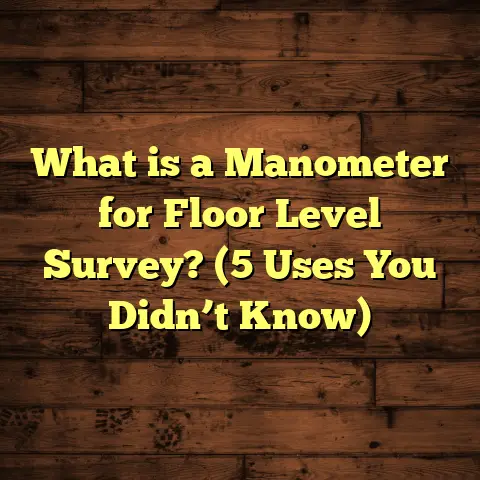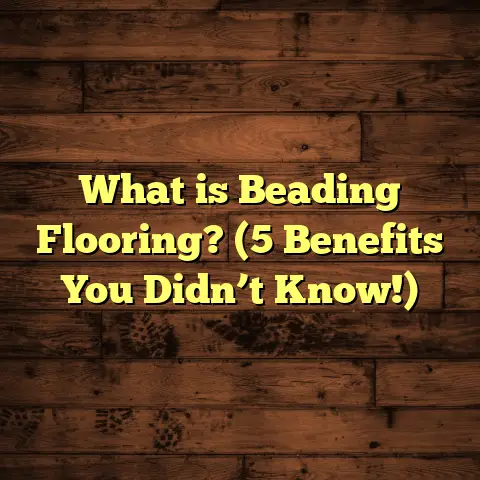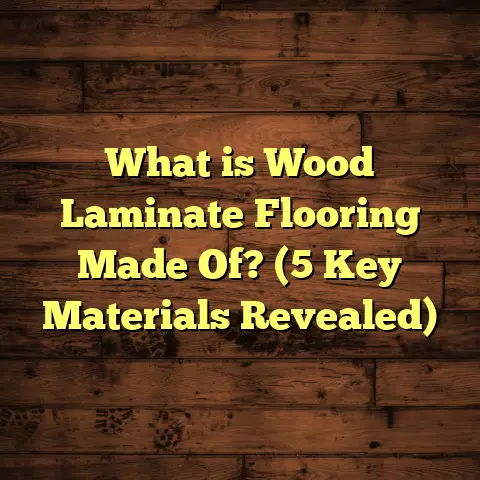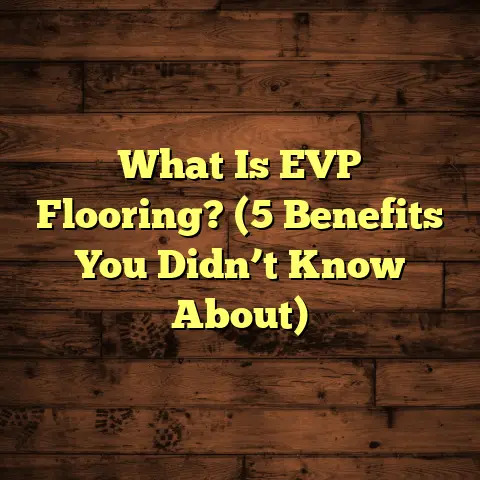What is Better Flooring: Vinyl or Laminate? (5 Key Differences Explained)
Focusing on the Future of Flooring Choices
When I think about flooring for a home or workspace,
I always try to look beyond the surface.
Sure, it needs to look good now, but what about five,
ten, or even twenty years from now? How will it hold up
underfoot, handle spills or changing seasons, and impact
my wallet over time?
Choosing between vinyl and laminate flooring is one of the
most common dilemmas I face as a flooring contractor.
Both have evolved dramatically in recent years, offering
many options at various price points. But knowing which one
fits your lifestyle comes down to understanding how these materials
behave in different conditions.
I’ve installed hundreds of floors over the last decade,
and I’ve learned that no single answer fits every situation.
What works for a busy family kitchen might not be right for a quiet office.
In this article, I’ll take you through five key differences between vinyl and laminate flooring —
sharing insights from my hands-on experience, backed by data and real-world examples.
By the end, you’ll feel confident in making a choice that suits your future needs.
What is Vinyl Flooring and Laminate Flooring?
Let’s start with the basics. If you’re new to these terms, here’s a simple explanation:
Vinyl Flooring Explained
Vinyl flooring is made from polyvinyl chloride (PVC), a type of plastic.
It’s manufactured into sheets, planks (LVP – luxury vinyl plank), or tiles (LVT – luxury vinyl tile).
Vinyl’s composition makes it naturally water-resistant and flexible.
This flexibility allows it to conform to slight imperfections in subfloors without cracking.
Vinyl floors come in two main types:
- Sheet Vinyl: Large continuous rolls that are glued down or loose-laid.
- Luxury Vinyl Planks/Tiles: Thicker pieces with realistic textures and patterns that click together like wood flooring.
One thing I appreciate about vinyl is its versatility.
It can mimic wood, stone, ceramic, or even abstract patterns with impressive realism.
Laminate Flooring Explained
Laminate flooring is a composite product consisting of several layers:
- Wear Layer: A clear protective layer that resists scratches and stains.
- Design Layer: A high-resolution photographic image of wood, stone, or tile.
- Core Layer: Usually made of high-density fiberboard (HDF) or medium-density fiberboard (MDF).
- Backing Layer: Stabilizes the floor and provides moisture resistance from below.
Laminate is designed to be a cost-effective alternative to hardwood floors.
It installs via a click-lock system without nails or glue, making it a popular DIY choice.
1. Durability and Water Resistance
Durability and water resistance are often at the top of my list when advising clients.
Vinyl Flooring Durability
Vinyl’s plastic makeup makes it highly water-resistant — almost waterproof if installed correctly.
This means spills, pet accidents, or humidity rarely cause damage.
In fact, in commercial settings like hospitals and schools, vinyl is a top choice because it stands up to heavy foot traffic and moisture.
Case study: I installed a luxury vinyl plank floor in a restaurant kitchen that faced constant water splashes and grease spills. After three years, the floor showed minimal wear with no warping or discoloration.
Commercial-grade vinyl can last 15–20 years with routine care. The wear layer thickness plays a big role here — thicker layers mean better protection.
Laminate Flooring Durability
Laminate floors are known for their scratch resistance due to the tough wear layer.
They handle things like pet claws and furniture sliding better than many hardwoods.
However, laminate’s Achilles heel is water exposure. The fiberboard core absorbs water quickly if moisture seeps into seams or edges, causing swelling and permanent damage.
I’ve seen laminate floors in basements warp after flooding or leaks from plumbing issues.
Data insight: According to a survey by the World Floor Covering Association (WFCA), laminate floors have an average lifespan of 15–25 years in dry environments but can fail within 2–3 years if exposed to repeated moisture incidents.
Personal Experience
I once worked on a lake house where my clients wanted hardwood aesthetics but needed something moisture-friendly. We debated between laminate and vinyl. After explaining the risks of moisture damage with laminate near water sources like bathrooms and mudrooms, they chose luxury vinyl plank — which still looks great five years later despite heavy use.
2. Installation Process and Flexibility
The way floors go down matters a lot — especially if you plan to DIY or want minimal disruption during installation.
Installing Vinyl Flooring
Vinyl installation varies by product type:
- Sheet Vinyl: Requires precise cutting and adhesive application. I usually recommend professional installation here because mistakes can cause bubbling or seams that trap dirt.
- Luxury Vinyl Planks/Tiles (LVP/LVT): These often feature click-lock systems that float over existing floors without glue or nails. This makes installation faster and easier.
- Peel-and-Stick Tiles: Great for quick fixes or small areas but less durable long-term.
Vinyl’s flexibility means it can be installed over many subfloors — concrete, plywood, even existing tile — as long as the surface is clean and level.
Installing Laminate Flooring
Laminate always requires an underlayment — a thin foam or cork pad beneath the planks — which adds sound insulation and moisture protection.
The click-lock system makes laminate popular with DIYers. However, laminate demands a perfectly flat subfloor because its rigid core doesn’t tolerate uneven surfaces well.
From personal work on older homes with uneven floors, I’ve seen laminate planks pop or separate if the subfloor isn’t prepped properly. This can end up costing more time and money than planned.
Time Efficiency & Waste Management
With both vinyl and laminate, waste is inevitable due to cuts around corners and edges. Usually, I factor in a 5-10% waste allowance when estimating materials.
Using tools like FloorTally has helped me streamline this process by giving precise cut lists and waste percentages based on room dimensions — saving trips to suppliers and avoiding material shortages mid-project.
3. Appearance and Design Options
Looks matter when choosing flooring — it sets the mood of your entire space.
Vinyl’s Visual Appeal
Advances in printing technology have transformed vinyl floors’ looks into something truly realistic.
High-end luxury vinyl planks can feature:
- Embossed textures matching wood grain or stone surface.
- Multiple color and finish options mimicking oak, walnut, slate, marble.
- Customizable patterns including herringbone or checkerboard tiles.
I remember installing vinyl floors in a modern condo where the client was amazed at how closely the floor resembled whitewashed hardwood — even under close inspection!
Laminate’s Design Strengths
Laminate offers very detailed photographic layers that produce sharp wood grain visuals with natural variation.
It tends to focus more on wood patterns than stone or tile looks but covers everything from rustic pine to exotic teak.
The surface finish can be matte or glossy depending on manufacturer specs.
Texture & Feel Underfoot
Vinyl is softer and warmer than laminate because of its plastic base and sometimes attached cork backing.
Laminate feels harder underfoot due to its fiberboard core but often has a smooth surface.
In colder climates, some clients prefer vinyl for its slightly cushioned feel that’s gentler on feet during winter mornings.
4. Cost – What You Should Expect
Money talks when planning any home improvement project — here’s what my experience shows about costs:
Vinyl Flooring Costs
Vinyl pricing depends heavily on quality:
- Basic sheet vinyl: $2–$5 per sq ft.
- Luxury vinyl planks/tiles: $3–$7 per sq ft.
- Installation: $1.50–$3 per sq ft depending on complexity.
Some brands add special features like antimicrobial coatings or extra thick wear layers — these push prices higher but offer longer life spans.
Laminate Flooring Costs
Laminate materials run from $1–$5 per sq ft depending on brand and thickness.
Installation costs tend to be higher because of underlayment requirements and subfloor prep — usually $2–$4 per sq ft.
Budgeting Tips From My Experience
I always recommend clients use cost calculators like FloorTally early in their planning stages. It helps avoid unexpected expenses by considering:
- Local labor rates.
- Material prices.
- Waste factors.
- Estimated time for installation phases.
For example, one customer thought laminate would be cheaper but after entering all variables into FloorTally realized that vinyl’s quicker installation saved about 15% overall on labor costs in their area.
5. Maintenance and Longevity
How much effort are you willing to invest in keeping your floors looking good?
Caring for Vinyl Floors
Vinyl is low maintenance:
- Sweep regularly.
- Use damp mop with gentle cleaner.
- Avoid abrasive scrubbing that might damage wear layer.
- No waxing or refinishing needed.
Spills wipe up easily; stains rarely set in due to vinyl’s nonporous surface.
Maintaining Laminate Floors
Laminate needs more careful cleaning:
- Avoid standing water or excessive moisture.
- Use dry mops or slightly damp cloths only.
- Use felt pads under furniture to prevent scratches.
- Cannot be refinished; scratches require plank replacement.
I once helped a client restore their laminate floor after some scratches by replacing about 10 damaged planks instead of doing an entire floor redo — which was much cheaper but still disruptive.
Longevity Comparison
Vinyl can last 10–20 years based on quality; laminate lasts roughly 15–25 years if kept dry and well-maintained.
Additional Factors That Shaped My Recommendations
Environmental Considerations
Vinyl production involves PVC plastics which have environmental concerns related to manufacturing emissions and disposal challenges. Some manufacturers now offer recycled content options or eco-friendly certifications like FloorScore for indoor air quality.
Laminate production uses wood fibers but often includes resins with formaldehyde emissions — though modern standards have reduced this significantly with low-VOC products becoming common.
If sustainability matters deeply to you, consider these environmental impacts alongside other factors.
Sound & Comfort
Vinyl tends to absorb sound better due to its softer base layers, which helps reduce footsteps noise. Laminate can be noisier unless paired with high-quality underlayment designed for soundproofing.
For apartments or multi-story homes where noise transfer is an issue, vinyl might be more comfortable for neighbors too!
Repair & Replacement
Vinyl floors are easier to repair spot-wise since individual planks or tiles can be replaced without disturbing whole sections if you keep spare pieces handy.
Laminate repairs usually involve replacing full planks which requires lifting adjacent boards carefully — trickier but manageable for professionals.
My Flooring Journey: Stories From the Field
Over my years installing floors in diverse homes, I’ve gathered some memorable lessons:
- A family with two young kids loved vinyl in their kitchen because spills were no hassle; their pets scratched laminate too much upstairs which pushed them towards vinyl there eventually.
- An elderly client preferred laminate upstairs because it felt sturdier underfoot when using walking aids — vinyl seemed too soft for their stability needs.
- A commercial office renovation used luxury vinyl tiles for easy maintenance while still giving the appearance of stone; employees appreciated the quieter workspace due to vinyl’s sound absorption.
These experiences taught me that no one-size-fits-all solution exists but understanding your priorities helps make smart choices faster.
Using Tools Like FloorTally in My Workflow
Handling multiple projects means I need reliable ways to estimate costs accurately without wasting client time or budget surprises.
FloorTally has been invaluable for me because:
- It consolidates labor rates by location so I don’t have to call around every time.
- It factors waste percentages automatically based on flooring type.
- It lets me compare material costs side-by-side for vinyl vs laminate options quickly.
- The user interface keeps everything organized so I can generate quotes fast—especially helpful during busy seasons!
- It supports realistic budget planning by showing total project costs upfront including installation labor which clients really appreciate before signing contracts.
Using tools like this has saved me hours per project while improving client satisfaction through transparency — something I recommend every contractor consider adopting.
Frequently Asked Questions I Hear About Vinyl vs Laminate
Q: Can I install vinyl over laminate?
A: Yes, if your laminate floor is level and securely installed. Vinyl’s flexibility usually adapts well as long as there are no bumps or loose boards below.
Q: Which floor feels warmer?
A: Vinyl generally feels warmer due to its softer base material; laminate feels harder underfoot but some underlayments can add warmth.
Q: Are there health concerns with either?
A: Low-VOC certified products exist for both types; ventilation during installation helps minimize off-gassing odors initially.
Q: Which is better for pet owners?
A: Vinyl resists scratches better from claws; laminate can show scratches more easily unless you choose high-quality scratch-resistant options.
Final Thoughts From Me
If you’re weighing vinyl against laminate flooring,
think about where you’ll install it,
how much moisture exposure there will be,
what kind of foot traffic you expect,
and how much time you want to spend cleaning up afterward.
Both have come so far that either can look beautiful while fitting many budgets,
but matching material properties to your lifestyle is key for long-term happiness with your floor choice.
Feel free to ask me anytime if you want help sizing up your space or estimating costs realistically—I’m happy to share what I know from years working right where your shoes meet the floor!





